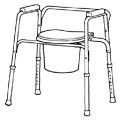Advance Care Program: Mobility
COMMODES
 PURPOSE: The purpose of bedside commodes is to provide an extension of the bathroom commode at the bedside or other area. By bringing the commode closer to the user, the individual has less distance to travel and in some cases, can perform these activities independently. Physically challenged individuals should never be left unattended. Contact your physician and/or therapist for transferring methods.
PURPOSE: The purpose of bedside commodes is to provide an extension of the bathroom commode at the bedside or other area. By bringing the commode closer to the user, the individual has less distance to travel and in some cases, can perform these activities independently. Physically challenged individuals should never be left unattended. Contact your physician and/or therapist for transferring methods.
TYPES: Commodes have evolved into a basic universal model. There still are many variations in capabilities, but most models can perform many roles. Most commodes function in their main role as a portable commode, but can also be fitted over bathroom commodes to facilitate an elevated toilet seat, or can be used as a shower seat. You can get models that have varying weight capacities and widths and with fixed or dropping arms.
USE: Bedside commodes are portable, meaning that they are not stationary. Each commode has rubber anti-slip tips that aid in the limitation of movement. The user must be able to, while unattended, stand, pivot and sit down safely. Commodes can also be adjusted for proper height. The height should be adjusted so the user can be safely transferred into and out of the commode. If you are using a drop-arm commode and using it to transfer into and out of a bed or chair, the seat height should be adjusted to the same height. The commode bucket is disposable and should be replaced anytime a crack is noticed. The user must exert the force of their weight directly over the unit. Do not allow weight to be exerted in any lateral direction.
SAFETY: Use extra caution for mobility risks and risks of falling, including:
- Poor lighting: Use of nightlights, flashlight by bedside, lamps or light switch that can be reached easily.
- Poor walk spaces: Fix loose floorboards, paint uneven floors, use wet floors signs, keep snow and ice cleared from entrances, ensure carpet is firmly attached to the stairs, do not walking in stocking feet, and remove loose rugs, clutter, cords, and excess oxygen tubing.
- Equipment: Replace worn or cracked walker, crutch, and cane tips, use colored oxygen tubing on light carpet, and tighten loose handrails.
- Bathroom: Install grab bars, use bath mats with suction cups, and use elevated toilet seat.
- Medications: Be aware of medications that may cause dizziness, drowsiness, and unsteadiness.
ACCESSORIES: Most medical equipment suppliers stock extra commode buckets, splashguards and rubber tips. They also stock many complimentary items that can assist the user in performing activities of daily living more independently. They usually maintain an extensive line of incontinent products, from briefs and underpads to skin cleansers and protectant creams.
More Mobility Topics
Canes & Quad Canes
Crutches
Walkers
Bath Benches & Safety Rails
Commodes
Grab Bars



